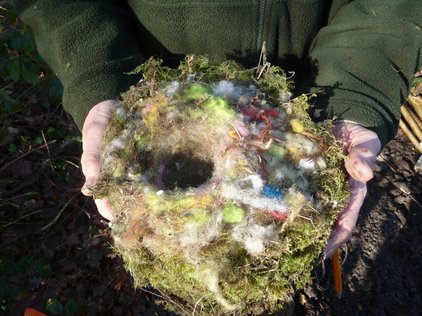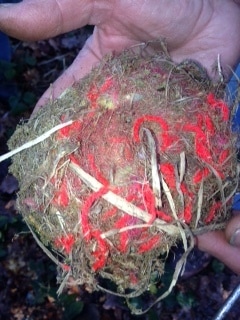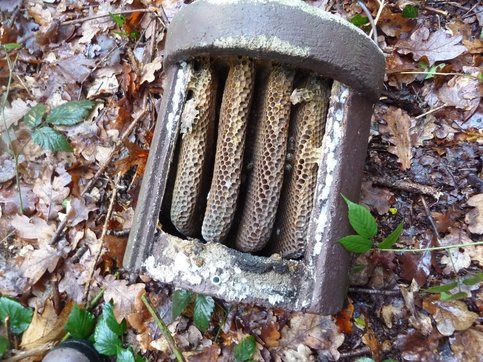We’ve put up boxes designed for tit species, tree creepers, nut hatches, wrens and owls and ones designed for a range of species like robins, blackbirds and flycatchers. The majority (75% +) are used most years although the numbers of eggs and/or skeletons in the nests vary considerably. When ‘fatalities’ are present in the occasional nest it is probable that something happened to one or both parent birds, but when it happens in many cases there may well be an underlying cause such as bad weather or lack of food (which are often linked).
Although the boxes are designed for different species, blue, great and coal tits don’t seem to realise this and often use boxes intended for tree creepers and nuthatches! If they use one of the latter, which are much larger than nest boxes designed for tits, the birds have to make much bigger nests and some are truly remarkable - and very cosy-looking! (See photo). Tits will use natural and manmade materials to make their nest and we often wonder where some of the latter comes from, although the commonest, a fluorescent yellow fluff probably comes from tennis balls lost by dog owners and their pets. Individuals birds (or pairs) would seem to vary in their preferences for nest building material, because some nests are made mainly of natural materials (grass, moss, dog hairs and feathers) while others in the same locality are made almost entirely of manmade materials (See photo).
We wondered how far birds foraged for nesting material, so last spring we cut some bright red wool into short (c. 5 cm) lengths and put these in a small net that we hung up in the Copse. Last week when we examined the boxes we checked if this wool was in any of the nests, which it was. Not unexpectedly the largest amount was in the nest box near where we hung the wool, but there were at least 7 strands in the elaborate nest built over 120m away - as tits fly!
It isn’t just birds that inhabit nest boxes not intended for them; bees do too! We realised there were bees in one box when we checked it last year when it was warm and the bees were active, so we left well alone! It was much colder last Saturday, so we took the front off the box which contained four honeycombs (See photo). They were so beautifully made we put the front back on the box and hung it back up; the bees are welcome occupants.
Photographs:
- Elaborate nest containing various types of manmade material (including at least 7 pieces of red wool).
- Nest with many pieces of red wool, but otherwise made of natural materials.
- Bird nest box containing a bees’ nest and four honeycombs.



 RSS Feed
RSS Feed
